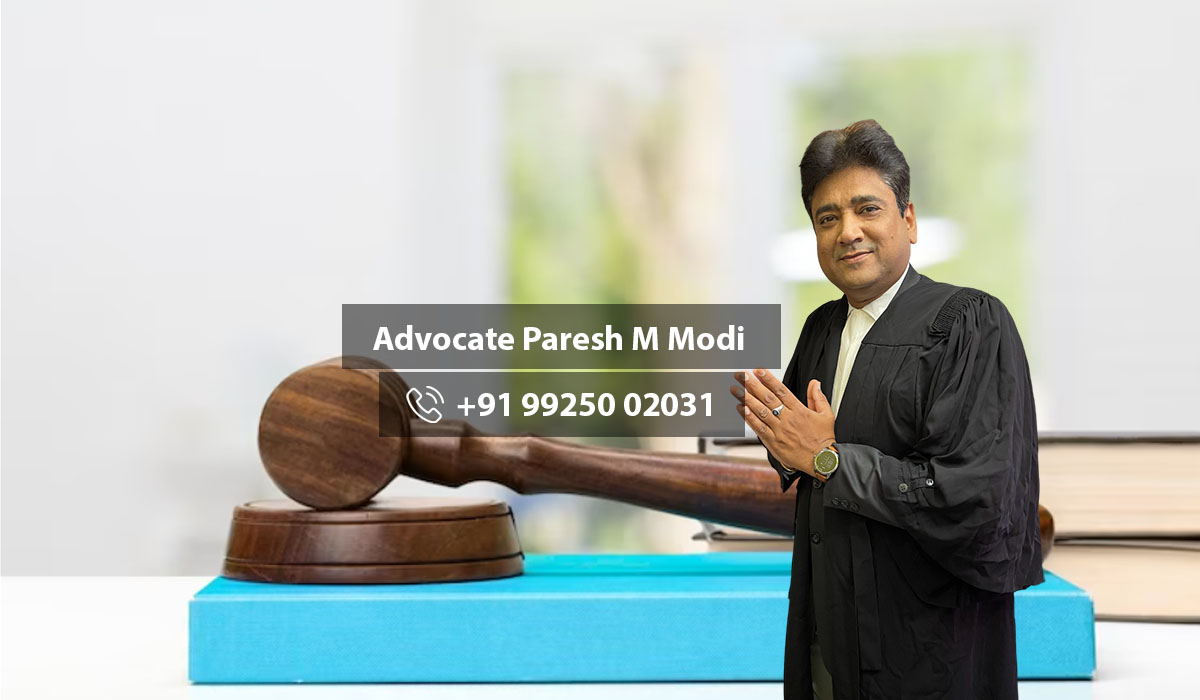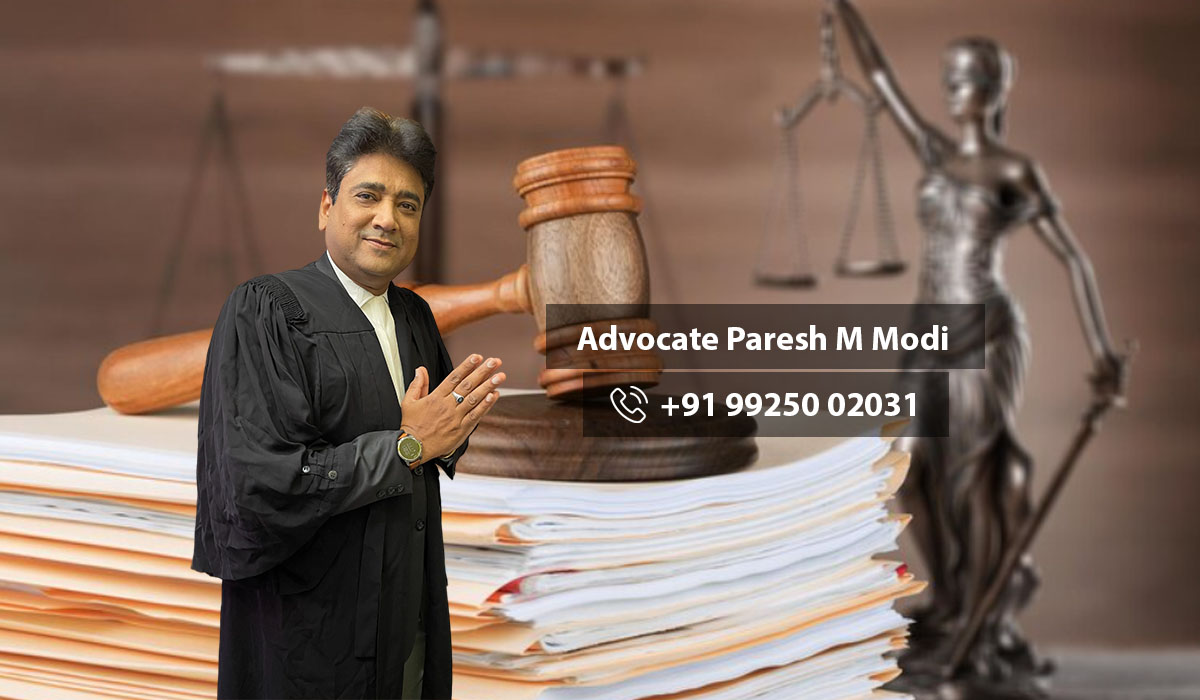Demolition of Properties of Persons or Gangs Involved in Anti-Social Activities in Gujarat India | Advocate Paresh Modi
The Gujarat government and police have taken strict actions against individuals and gangs involved in anti-social activities, including demolishing illegal properties. However, the legality of such demolitions depends on compliance with existing laws. Below are the key laws and legal aspects governing such actions:
Applicable Laws for Demolition
Gujarat Prevention of Anti-Social Activities Act, 1985 (PASA)
- Used to detain individuals involved in repeated anti-social activities.
- The act allows preventive detention but does not directly permit property demolition.
Gujarat Land Revenue Code, 1879
- Sections 202 & 203: Authorities can remove encroachments on government land after due process.
Gujarat Town Planning and Urban Development Act, 1976
- Section 260: Local authorities can demolish unauthorized constructions after serving notice.
Indian Penal Code, 1860 (IPC) & Criminal Procedure Code, 1973 (CrPC)
- Section 133 CrPC: Magistrates can order the removal of illegal structures causing public nuisance.
The Gujarat Police Act, 1951
- Provides powers to take action against criminals, but it does not directly allow demolition.
Prevention of Damage to Public Property Act, 1984
- If the property is illegally constructed on public land, it can be removed after due legal process.
Unlawful Activities (Prevention) Act, 1967 (UAPA) & National Security Act (NSA), 1980
- If the property is used for terrorism or unlawful activities, authorities may take action, but demolition must follow legal procedures.
Is Demolition Legal?
Demolition of properties is legal only if due process of law is followed. This means:
- Authorities must issue prior notices.
- The owner must be given a chance to present their case.
- There should be a valid reason, such as illegal construction or encroachment.
- The order must comply with court directions.
Illegal demolitions without proper legal process violate Article 21 (Right to Life and Property) and Article 300A (No deprivation of property without legal authority) of the Indian Constitution.
Legal Remedies & Defenses Against Demolition in Gujarat
Filing a Writ Petition in High Court or Supreme Court
- Under Article 226 (High Court) or Article 32 (Supreme Court) to challenge illegal demolitions.
- Can seek a stay order or compensation for wrongful demolition.
Appealing Before Local Authorities or Tribunal
- If a demolition notice is issued under town planning or revenue laws, an appeal can be filed with the municipal authority or appellate tribunal.
Civil Suit for Injunction & Compensation
- A property owner can file a civil suit for injunction to stop the demolition.
- If property is demolished illegally, a compensation claim can be made against the government.
Filing a Contempt Petition
- If authorities act against a court’s stay order, a contempt petition can be filed.
Claiming Violation of Fundamental Rights
- Demolition without notice violates Article 14 (Right to Equality) & Article 21 (Right to Life & Dignity) and can be challenged in court.
Conclusion
While the Gujarat government has laws to take action against anti-social elements, property demolitions must follow legal procedures. Arbitrary or illegal demolitions can be challenged through writ petitions, civil suits, and appeals before local bodies. Courts have repeatedly held that even criminals have legal rights, and any action must be as per the rule of law.
For legal assistance in Gujarat regarding property demolition cases, Advocate Paresh M Modi can provide expert legal solutions. You can contact him at:
📞 Mobile: +91 9925002031 (WhatsApp message only from 9 AM to 9 PM)
📞 Office Landline: +91-79-48001468 (10:30 AM to 6:30 PM, working days)
📧 Email: advocatepmmodi@gmail.com
🌐 Website: www.advocatepmmodi.in
📍 Office Address: Office No. C/112, Supath-2 Complex, Opp. Kohinoor Plaza Hotel, Near Old Wadaj Bus Stand, Ashram Road, Ahmedabad – 380013, Gujarat, India.
IN GUJARATI LANGUAGE
ગુજરાત રાજ્યમાં ગેંગસ્ટરોની મિલ્કત ડીજીપી પોલીસ દ્વારા ધરાશાયી કરવાનું કાયદેસર છે? | Advocate Paresh M Modi
ગુજરાતમાં ગેંગસ્ટરો અને અસામાજિક તત્વોની મિલ્કતોને ધરાશાયી કરવાની પોલીસની કાર્યવાહી ચર્ચાનો વિષય બની છે. શું આ કાર્યવાહી કાયદેસર છે? પોલીસને ક્યા કાયદાઓ હેઠળ અધિકાર આપવામાં આવ્યા છે? અને આવા કેસોમાં કાયદેસર બચાવ અને ઉપાયો શું છે?
પોલીસ દ્વારા મિલ્કત ધરાશાયી કરવાના લાગુ કાયદાઓ
ગુજરાત અસામાજિક પ્રવૃત્તિ નિવારણ અધિનિયમ, 1985 (PASA)
- ગેંગસ્ટરો અથવા અસામાજિક તત્વો સામે પ્રતિબંધાત્મક કાર્યવાહી માટે વપરાય છે.
- ધરપકડ અને રાષ્ટ્રીય સુરક્ષા માટે વપરાય છે, પરંતુ સીધી મિલ્કત ધરાશાયી કરવાની છૂટ આપતો નથી.
ગુજરાત જમીન રાજસ્વ કાયદો, 1879
- કલમ 202 & 203: સરકારી જમીન પર ગેરકાયદેસર બાંધકામ સામે કાર્યવાહી કરી શકાય.
ગુજરાત ટાઉન પ્લાનિંગ અને અર્બન ડેવલપમેન્ટ અધિનિયમ, 1976
- કલમ 260: નોટિસ આપ્યા બાદ બિનઅધિકૃત બાંધકામ દૂર કરી શકાય.
ભારતીય ફોજદારી પ્રક્રિયા સંહિતા, 1973 (CrPC)
- કલમ 133: જાહેર ખોટ કરતું ગેરકાયદેસર બાંધકામ દૂર કરવા મેજિસ્ટ્રેટ આદેશ આપી શકે.
ગુજરાત પોલીસ અધિનિયમ, 1951
- પોલીસ ગેંગસ્ટરો સામે કાર્યવાહી કરી શકે, પણ મિલ્કત તોડી પાડવાનો સ્પષ્ટ ઉલ્લેખ નથી.
જાહેર મિલ્કત નુકસાન નિવારણ અધિનિયમ, 1984
- જો મિલ્કત સરકારી જમીન પર ગેરકાયદેસર હોય, તો તેને કાયદેસર પ્રક્રિયા હેઠળ દૂર કરી શકાય.
અનૈતિક પ્રવૃત્તિઓ (નિષેધ) અધિનિયમ, 1956 (UAPA) & રાષ્ટ્રીય સુરક્ષા અધિનિયમ (NSA), 1980
- આતંકવાદી અથવા અસામાજિક પ્રવૃત્તિઓમાં વપરાતી મિલ્કત સામે કાર્યવાહી શક્ય છે, પણ ન્યાયિક પ્રક્રિયા મુજબ જ.
ડીજીપી પોલીસના અધિકાર અને ક્ષેત્રાધિકાર
પોલીસ સીધી મિલ્કત તોડી શકે નહીં
- કોઈ પણ મિલ્કત ધરાશાયી કરવા માટે મહાનગરપાલિકા, તાલુકા પંચાયત અથવા રાજસ્વ વિભાગના અધિકારીઓની મંજૂરી અનિવાર્ય છે.
- સુપ્રીમ કોર્ટ અને હાઈકોર્ટના વિવિધ ચુકાદાઓ અનુસાર, કોઈ વ્યક્તિની મિલ્કત તોડવી તેની બંધારણીય હકોનું ઉલ્લંઘન છે.
મિલ્કત ગેરકાયદેસર હોય તો નોટિસ આપવી પડશે
- અધિનિયમ અને કાયદા મુજબ, કોઇપણ બાંધકામ તોડતા પહેલા પુરાવા પર આધારિત નોટિસ આપવી જરૂરી છે.
કાયદેસર કાર્યવાહી સિવાય સીધી મિલ્કત તોડવી ગેરકાયદેસર ગણાશે
- ભારતનું બંધારણ કલમ 21 (જીવન અને સંપત્તિનું અધિકાર) અને કલમ 300A (કાયદેસર મંજૂરી વગર મિલ્કતથી વંચિત કરી શકાતું નથી) મુજબ, સરકાર કે પોલીસ મિલ્કત તોડવા માટે ન્યાયસંગત કારણ અને મંજૂરી હોવી જોઈએ.
કાયદેસર બચાવ અને ઉપાયો
ગુજરાત હાઈકોર્ટ અથવા સુપ્રીમ કોર્ટમાં રિટ અરજી (Writ Petition) દાખલ કરો
- કલમ 226 (હાઈકોર્ટ) અને કલમ 32 (સુપ્રીમ કોર્ટ) હેઠળ ગેરકાયદેસર મિલ્કત તોડવાના આદેશને પડકારવી શકાય.
- સ્ટે ઓર્ડર મેળવવા માટે અરજી કરી શકાય.
સ્થાનિક તંત્ર અથવા ટ્રિબ્યુનલમાં અપીલ કરો
- નગરપાલિકા અથવા રાજસ્વ વિભાગ દ્વારા મિલ્કત તોડવાનો આદેશ હોય, તો તુરંત અપીલ કરી શકાય.
ન્યાયાલયમાં સ્ટે અને વળતરની અરજી
- સીવિલ કેસ (Injunction Suit) દાખલ કરીને સ્ટે ઓર્ડર મેળવવો.
- અન્યાયી મિલ્કત તોડવામાં આવી હોય તો સરકારી તંત્ર સામે વળતરની માંગણી કરી શકાય.
કોર્ટના સ્ટે ઓર્ડર પછી પણ તોડફોડ થાય તો કોર્ટમાં તિરસ્કાર અરજી (Contempt Petition) ફાઈલ કરો
- જો સ્ટે ઓર્ડર હોવા છતાં તોડફોડ કરવામાં આવે, તો જવાબદાર અધિકારીઓ સામે કાનૂની પગલા લઈ શકાય.
મૂળભૂત અધિકારના ઉલ્લંઘન માટે કોર્ટમાં અરજી કરો
- કલમ 14 (સમાનતા અધિકાર) અને કલમ 21 (જીવન અને સંપત્તિ અધિકાર) ના ઉલ્લંઘન સામે કોર્ટમાં અરજી કરી શકાય.
નિષ્કર્ષ
ગુજરાત પોલીસ દ્વારા ગેંગસ્ટરોની મિલ્કત તોડવાની કાર્યવાહી કાયદેસર હોય શકે છે જો તે તમામ કાયદાકીય પ્રક્રિયાઓ અનુસરે. પોલીસે સીધા જ તોડફોડ કરવી ગેરકાયદેસર છે. જો કોઇને ગેરકાયદેસર મિલ્કત તોડવાના કેસમાં ન્યાય મેળવવો હોય, તો વકીલની સલાહ લેવી જરૂરી છે.
ગુજરાતમાં મિલ્કત તોડફોડના કેસમાં કાનૂની સલાહ માટે, એડવોકેટ પરેશ એમ મોદી સાથે સંપર્ક કરો:
📞 મોબાઇલ: +91 9925002031 (ફક્ત વોટસેપ મેસેજ સવારે 9 થી રાતે 9 સુધી)
📞 ઓફિસ લૅન્ડલાઇન: +91-79-48001468 (સવારે 10.30 થી સાંજે 6.30 સુધી, કામકાજના દિવસોમાં જ)
📧 ઈમેલ: advocatepmmodi@gmail.com
🌐 વેબસાઇટ: www.advocatepmmodi.in
📍 ઓફિસ સરનામું:ઓફિસ નં. C/112, સુપથ-2 કોમ્પ્લેક્સ, કોહિનૂર પ્લાઝા હોટલ સામે, જૂના વાડજ બસ સ્ટેન્ડ પાસે, આશ્રમ રોડ, અમદાવાદ – 380013, ગુજરાત, ભારત.



